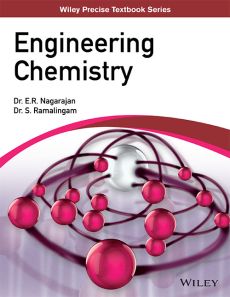Wiley's Engineering Chemistry
ISBN: 9788126567843
540 pages
For more information write to us at: acadmktg@wiley.com

Description
The Engineering Chemistry course for undergraduate students is designed to strengthen the fundamentals of chemistry and then build an interface of theoretical concepts with their industrial / engineering applications. This book is structured keeping in view the objective of the course and is intended as a textbook for first year B.Tech/B.E. students of all engineering disciplines. The book aims to impart students an in-depth knowledge of various aspects of chemistry as applied to engineering.
Preface
Contents
Unit-I: Water Technology
1. Water and its Treatment
1.1 Sources of Water
1.2 Impurities in Water
1.3 Hardness of Water
1.4 Determination of Hardness of Water
1.5 Disadvantages of Hard Water
1.6 Alkalinity of Water
1.7 Analysis of Water
1.8 Water Quality Parameters
1.9 Municipal Water
1.10 Treatment of Water for Domestic Purposes
1.11 Boiler Feed Water
1.12 Techniques for Water Softening
1.13 Wastewater
Unit – II: Macroscopic Properties of Systems in Equilibrium
2. Thermodynamics and Chemical Equilibrium
2.1 Some Important Terms in Thermodynamics
2.2 The First Law of Thermodynamics
2.3 Enthalpy or Heat Content
2.4 Applications of First Law of Thermodynamics
2.5 Thermochemistry
2.6 Joule–Thomson Effect
2.7 The Second Law of Thermodynamics
2.8 Entropy
2.9 The Third Law of Thermodynamics
2.10 Free Energy
2.11 Concept of Activity
2.12 Maxwell Relations
2.13 Thermodynamic Criteria for Equilibrium
2.14 Physical Equilibrium
2.15 Chemical Equilibrium
2.16 Ionic Equilibrium
Additional Topic A
A.1 Van’t Hoff Isotherm (Expression for equilibrium constant)
A.2 Problems Based on Entropy
A.3 Problems Based on Gibbs Free Energy
A.4 Problems Based on Gibbs–Helmholtz Equation
A.5 Problems Based on Free Energy Change and Equilibrium Constant
3. Phase Rule
3.1 Definition of Terms
3.2 Phase Rule
3.3 Phase Diagram
3.4 One-Component Systems
3.5 Two-Component Systems
Additional Topic B
B.1 Phase Rule
Unit – III: Electrodics
4. Electrochemistry
4.1 Electrical Conductance
4.2 Electrochemical Cells
4.3 Electrode Potential
4.4 Galvanic Cells
4.5 Nernst Equation
4.6 Measurement of EMF of the Cell
4.7 Reference Electrodes
4.8 Single Electrode Potential
4.9 Types of Electrodes
4.10 Glass Electrode
4.11 Concentration Cells
4.12 Batteries
4.13 Classical Batteries
4.14 Modern Batteries
4.15 Fuel Cells
Additional Topic C
C.1 Solar Battery
5. Corrosion and its Control
5.1 Corrosion in Metals and Alloys
5.2 Corrosion Cell
5.3 Types of Corrosion
5.4 Types of Electrochemical Corrosion
5.5 Other Types of Corrosion
5.6 Factors Influencing Rate of Corrosion
5.7 Corrosion Control Methods
5.8 Protective Coatings
5.9 Metal Finishing
5.10 Electroplating Process
5.11 Effect of Plating Variables on Nature of Electrodeposit
5.12 Surface Preparation
5.13 Electroplating of Chromium and Silver
5.14 Electroless Plating
Unit – IV: Engineering Materials
6. Polymers
6.1 Terminology
6.2 Classification of Polymers
6.3 Types of Polymerization
6.4 Mechanism of Addition Polymerization
6.5 Polymerization Techniques
6.6 Molecular Weights of Polymers
6.7 Structure–Property Relationship of Polymers
6.8 Plastics
6.9 Some Important Commercial Thermoplastics
6.10 Some Important Commercial Thermosetting Resins
6.11 Elastomers (Rubbers)
6.12 Some Commercially Important Synthetic Rubbers
6.13 Fibers
6.14 Some Important Synthetic and Semisynthetic Fibers
6.15 Composites
6.16 Adhesives
6.17 Conducting Polymers
6.18 Semiconducting Polymers
6.19 Natural Polymers (Biopolymers)
6.20 Ion Exchange Resins
6.21 Biodegradable Polymers
Additional Topic D
D.1 Polycarbonate (PC)
D.2 Determination of Molecular Weight of Polymers by Viscometry
7. Nanochemistry
7.1 Properties of Nanomaterials
7.2 General Methods of Synthesis
7.3 Characterization of Nanomaterials
7.4 Materials Self-Assembly
7.5 Two-Dimensional Assemblies
7.6 Mesoscale Self-Assembly (MESA)
7.7 Coercing Colloids
7.8 Supramolecular Structures
7.9 Nanoscale Materials
7.10 General Applications of Nanomaterials
7.11 Future Perspectives of Nanochemistry
Unit-V: Instrumental Methods of Analysis
8. Instrumental Methods of Analysis
8.1 Electroanalytical Methods
8.2 Electromagnetic Radiation
8.3 Molecular Spectroscopy
8.4 Basic Spectroscopy Instrumentation
8.5 Infrared Spectroscopy
8.6 NMR Spectroscopy
8.7 UV–Visible Spectroscopy
8.8 Atomic Absorption Spectroscopy (AAS)
8.9 Flame Photometry
8.10 Mass Spectroscopy
8.11 Chromatography
8.12 Thermal Analysis
Additional Topic E
E.1 UV-Visible Spectroscopy
E.2 Chromatography
E.3 Scanning Electron Microscopy (SEM)
E.4 High Performance Liquid Chromatography (HPLC)

